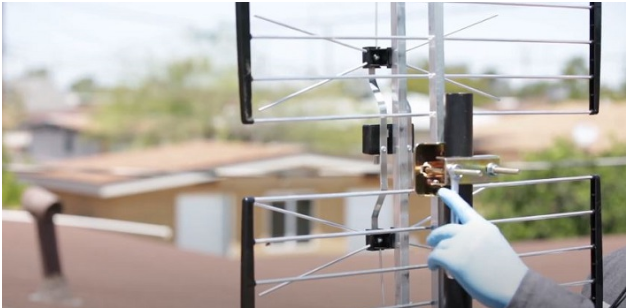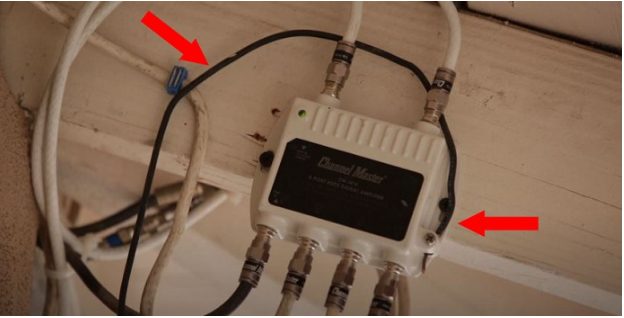Installing your antenna on the roof of your house is the best way to ensure steady, uninterrupted communications. Placing your TV antenna on the roof aids in transmitting a strong signal from the broadcast towers to your television.
Several people, however, are clueless about how to install a TV antenna on a roof. Mounting the antenna at such a high altitude may also appear difficult at first. Nevertheless, in this guide, I will teach you how to install a TV antenna on the roof in no time safely.
In general, here’s how to install an antenna on the roof:
- Establish the spot where you want to install the antenna on the roof.
- Assemble the antenna for your roof on the ground.
- Mount it at least 10-feet above the tallest point of your roof.
- Secure it in place.
Here is a step-by-step guide below:
5 Steps to Install Your Outdoor Antenna on the Roof
Even though mounting an antenna on the roof is not difficult, it is necessary to take a few procedures to guarantee that you complete the job safely and correctly.
I have included all of the information below, so you will know exactly what you need to do:
Step #1: Establish the Antenna’s Placement

Getting the correct spot for your outdoor antenna can make a huge difference between obtaining a few channels and gaining all of your local stations.
Whether in your attic or living room, placing an antenna outside is always preferable to install one inside. Your home’s construction, such as walls, attic insulation, or a metal roof, produces interference and degrades the signal. (1)
As a result, an outside antenna will receive minor disturbance, while local impediments like woods and hills may still be present.
If possible, attempt to get a clear and direct line of vision to transmission towers while installing your outside antenna to reduce potential interference.
Step #2: Install the Antenna

You’ve already selected the optimum location for your antenna. You’re now ready to begin the antenna installation process.
Your objective should be to have everything ready, including the antenna, before hauling it all to the roof.
- Installing on Wood: To keep the antenna in place, you should utilize wall mount brackets. Install wall brackets on solid wood pieces of your wall, spacing them far apart for added support. (2)
- Installing in a Chimney: Several individuals utilize their chimney as an antenna installation foundation. It’s simple to set up there but there may be drawbacks. For starters, make sure the design of the chimney is secure. Smoke and heat can harm the antenna’s components and performance over time. In any case, mounting your mast with a sturdy set of chimney mount straps is highly recommended.
- Installing on a Rooftop: A base bracket can be attached to your rooftop. A base mount is versatile, allowing it to be used in other locations such as the roof or on a wall. Alternatively, you may use a tripod base to mount your antenna on the roof. When utilizing any form of the base mount, use lag screws to hold them to substantial wood, such as attic rafters. Depending on its altitude, you may even consider using guy wires to secure the mast.
Step #3: Connect the Cable to Your Device
It is vital to remember that a coaxial cable antenna might cause performance degradation and interference; therefore, care should be given when mounting and linking it.
You should have a line with sufficient length between your antenna and your tv or converter box. Along the way, try to avoid sudden curves or bends.
If you have spare coax from a prior satellite or premium cable antenna setup, you can use it; however, do not put OTA antenna transmissions into the same coax as your cable broadband.
Step #4: Attach the Coaxial Cable to Your TV

Lastly, you will need to hook your coaxial cable antenna to the F socket input on the back panel of either the converter box or the tv set.
Start a channel scan to acquire the transmitted channels after the coaxial is connected, and compare them to the list you created from your channel assessment in the previous stage. You will have to re-aim the antenna in a different direction if you are not getting enough channels.
Step #5: Ground Wire Your Device

Once you have established great reception with your outside antenna, you must ground wire it to safeguard it from static discharges and the impacts of unintended lightning strikes.
FAQs
What is the ideal height for a TV antenna?
The antenna should be installed at least 10-20 feet off the ground. However, regardless of how high you may install it, make sure that it eliminates the majority of local obstructions in its line of vision to towers.
Consider that if a nearby home or structure covers the antenna, TV broadcasts from that area will most likely be blocked or weakened.
If you are placing the antenna on a metal roof, I recommend mounting it at least one meter above the roof to reduce interference.
Is it necessary to buy and set up an outside antenna?
The answer is dependent on where you are regarding the tv networks you want to watch. A set-top antenna may be adequate, but it is also unstable and requires regular maintenance. A mounted antenna on your roof or wall will save you time and effort in the long run.
There are antennas created expressly for watching digital channels; if you know you will only be watching digital channels, any good quality VHF/UHF antenna will suffice. You’ll have no trouble watching your favorite networks.
What is the ideal size for a TV antenna?
Another consideration for your setup is antenna size. Certain antennas are small and compact, making them easy to position in various places of your home, such as the attic. However, some can also be huge and wide.
Keep in mind that the bigger the antenna, the broader it’s surface area and, in turn, the equivalent transmission strength.
Take a look at some of our related articles below.
References
(1) metal roof – https://www.bobvila.com/articles/metal-roof-pros-and-cons/
(2) wood – https://www.britannica.com/science/wood-plant-tissue

